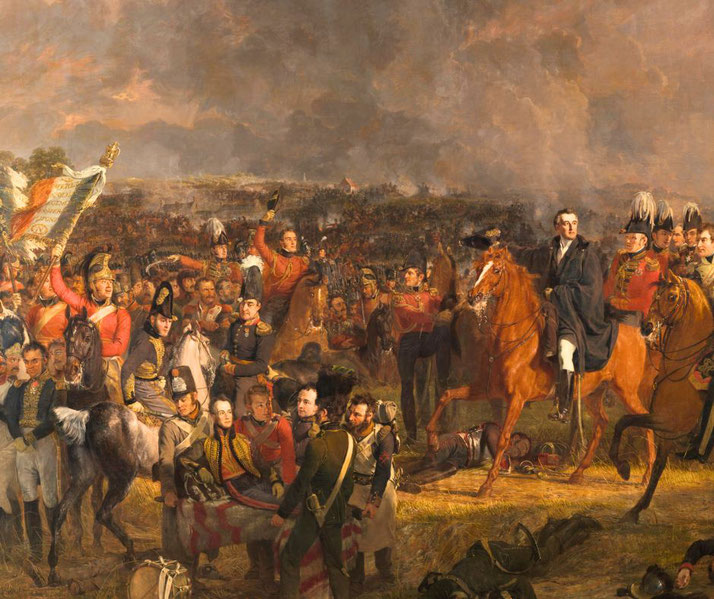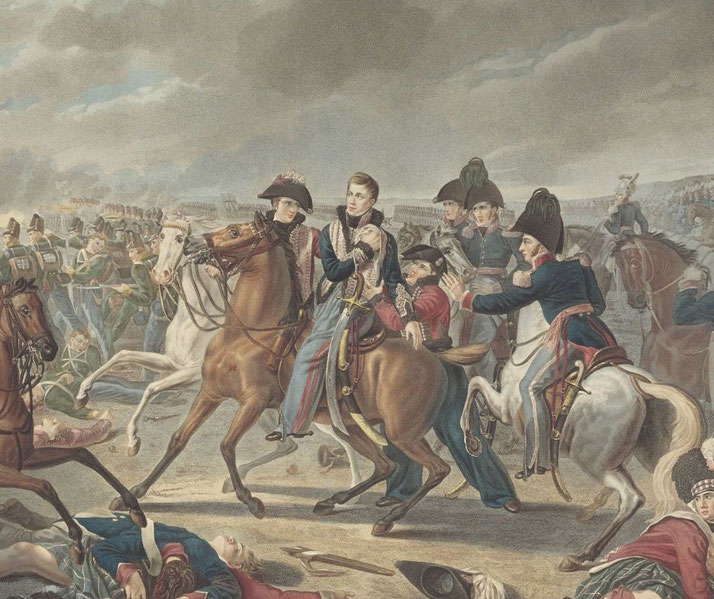The Battle of Waterloo and Napoleon's last stand

The Battle of Waterloo, fought on June 18, 1815, stands as one of the most significant events in European history. This epic confrontation marked the end of the Napoleonic Wars and the reign of Napoleon Bonaparte, one of the most influential figures of his time.
The battle's outcome had far-reaching consequences, reshaping the political landscape of Europe and setting the stage for the 19th century.
In the rolling farmland near the town of Waterloo in present-day Belgium, over 200,000 soldiers from several nations clashed in a day-long battle.
The French Army, led by the recently returned from exile Napoleon Bonaparte, faced two of the armies of the Seventh Coalition: an Anglo-allied army under the command of the Duke of Wellington, and a Prussian army under the command of Field Marshal Blücher.
The battle was characterized by its ferocity, tactical maneuvers, and the high stakes involved for both the participants and the whole of Europe.
The background to the battle
The Napoleonic Wars, a series of major global conflicts fought from 1803 to 1815, were primarily driven by the imperial ambitions of Napoleon Bonaparte, the French military and political leader who rose to prominence during the French Revolution.
His strategic brilliance and charismatic leadership led France to dominate much of Europe, fundamentally altering the continent's political landscape.
However, Napoleon's expansionist policies and the disruption they caused led to the formation of various coalitions by other European powers, aimed at curbing French influence and restoring the balance of power.
The Seventh Coalition, comprising the United Kingdom, Prussia, Austria, and several other nations, was the last of these alliances.
The coalition's goal was to end Napoleon's rule, which had been briefly interrupted by his exile to the island of Elba in 1814, only for him to escape and return to power in France in a period known as the Hundred Days.
Key figures in this historical tableau include Napoleon himself, a man of immense ambition and military genius; the Duke of Wellington, Arthur Wellesley, a cautious and meticulous British general who had successfully fought French forces in the Peninsular War; and Gebhard Leberecht von Blücher, the Prussian field marshal known for his tenacity and aggressive approach to warfare.
These leaders, each with their distinct styles and philosophies of command, would play pivotal roles in the events that unfolded on the battlefield of Waterloo.
How each side prepared for the final showdown
The stage for the Battle of Waterloo was set by a series of events that began with Napoleon Bonaparte's audacious return from exile.
In February 1815, Napoleon escaped from the island of Elba, where he had been exiled after his abdication the previous year.
He landed in France with a small force of loyal soldiers and began what is now known as the Hundred Days campaign.
As he marched towards Paris, the French troops sent to stop him instead joined his cause, and Louis XVIII, the reinstated Bourbon king, fled.
By March, Napoleon was once again in control of France.
However, his return to power was not welcomed by the other European powers. The Seventh Coalition, comprising Britain, Prussia, Austria, and Russia, among others, quickly formed with the aim of ending Napoleon's rule.
The coalition began mobilizing their armies, preparing for a confrontation with Napoleon's forces.
In the meantime, Napoleon, aware of the coalition's intentions, decided to strike first.
He planned to attack the coalition armies before they could fully assemble and unite.
His strategy was to divide and conquer, aiming to defeat the British and Prussian armies separately.
By mid-June, the French Army, rejuvenated under Napoleon's leadership, was ready to march into Belgium, where the British and Prussian forces were stationed.
On the other side, the Duke of Wellington, commanding the British and allied forces, and Field Marshal Blücher, leading the Prussian Army, were preparing their own strategies.
Wellington, known for his defensive tactics, chose a position near the village of Waterloo to make his stand.
He understood the terrain well and knew that the ridges and the walled farm complexes in the area could be used to his advantage.
Meanwhile, Blücher promised to support Wellington's forces, intending to join forces and present a united front against Napoleon.
The battle begins...
The Battle of Waterloo commenced on the morning of June 18, 1815, near the town of Waterloo in present-day Belgium.
The French Army, commanded by Napoleon Bonaparte, faced off against the armies of the Seventh Coalition, an Anglo-allied army under the command of the Duke of Wellington, and a Prussian army under the command of Field Marshal Blücher.
The opposing forces were a study in contrast. The French Army, numbering about 72,000, was a mix of veterans from Napoleon's previous campaigns and newer recruits.
Napoleon himself was a seasoned commander, known for his innovative tactics and ability to inspire his troops.
On the other side, the Anglo-allied army, numbering about 68,000, was a diverse force comprising British, Dutch, Belgian, and German soldiers.
The Duke of Wellington, a cautious and methodical leader, commanded this force. Meanwhile, the Prussian Army, numbering about 50,000, was located to the east, ready to support Wellington's forces.
The battle began with a French attack on the château of Hougoumont, a large farmhouse garrisoned by Wellington's troops.
This attack was intended as a diversion to tie down the coalition's reserves. Meanwhile, Napoleon prepared for the main assault on Wellington's center and left.
However, the battle did not proceed as Napoleon had planned. The coalition forces put up a staunch defense, and the arrival of the Prussians on the battlefield in the afternoon added to the French Army's difficulties.

The key turning points of the battle
The battle began in earnest with a French attack on Hougoumont, a large farmhouse on Wellington's right flank.
This attack, led by Napoleon's brother, Prince Jerome, was intended to draw out the coalition's reserves and weaken their center and left.
However, the British and allied troops stationed at Hougoumont put up a fierce resistance, turning the farmhouse into a deadly trap for the French soldiers.
While the battle raged at Hougoumont, Napoleon prepared for the main assault on Wellington's center and left.
He launched a massive infantry attack, led by Comte d'Erlon's I Corps. However, this attack was repulsed by a combination of British infantry squares, artillery fire, and a timely charge by the British heavy cavalry led by the Earl of Uxbridge.
This counterattack, though successful, left the British cavalry exposed, and they suffered heavy losses from the French cavalry counter-charge.
In the afternoon, the French launched several cavalry attacks against the British squares.
These attacks, led by Marshal Ney, were intended to break the British lines, but they were unsuccessful.
The British infantry, formed into defensive squares, withstood the French cavalry charges with remarkable discipline and courage.
The turning point of the battle came with the arrival of the Prussian Army. Despite having fought a hard battle against the French at Ligny two days earlier, the Prussians, under the command of Field Marshal Blücher, had managed to regroup and march to join Wellington's forces.
Their arrival on the battlefield in the late afternoon put additional pressure on the French right flank.
In a last-ditch effort to break the coalition's lines, Napoleon sent his elite Imperial Guard, which had been held in reserve, to attack Wellington's center.
However, this attack was also repulsed, marking the first time the Imperial Guard had been defeated in battle.
This event shattered the morale of the French troops, and a general retreat soon turned into a rout.
The aftermath and consequences of Waterloo
The battle resulted in heavy casualties on both sides. The French Army suffered approximately 41,000 casualties, including killed, wounded, and missing.
The Seventh Coalition also suffered heavily, with around 24,000 casualties for Wellington's Anglo-allied army and about 7,000 for the Prussians.
The immediate consequence of the battle was the end of Napoleon Bonaparte's rule.
Following the defeat at Waterloo, Napoleon returned to Paris, where he abdicated for the second time on June 22, 1815.
He was later exiled to the remote island of Saint Helena in the South Atlantic, where he lived out the rest of his life until his death in 1821.
The political repercussions of the Battle of Waterloo were significant. The defeat of Napoleon marked the end of the series of wars that had convulsed Europe since the French Revolution.
The Congress of Vienna, which had been interrupted by Napoleon's return, resumed its work.
The major European powers sought to restore the balance of power and prevent any single nation from dominating the continent as France had done under Napoleon.
The political map of Europe was redrawn, with many of the changes enduring for the rest of the 19th century.
The Battle of Waterloo also had a lasting impact on military strategy. The lessons learned from the battle, such as the importance of combined arms tactics, the effective use of terrain, and the value of coalition warfare, influenced military thinking in the years that followed.

Why Waterloo is such an important historical event
The historical significance of the Battle of Waterloo cannot be overstated. It marked the end of the Napoleonic Wars, a series of conflicts that had reshaped Europe and had a profound impact on the world.
The battle brought to a close the era of Napoleon Bonaparte, a man whose ambition and military genius had changed the course of history.
The Battle of Waterloo is significant for its role in ending the cycle of war and revolution that had begun with the French Revolution in 1789.
With Napoleon's final defeat, the major European powers were able to establish a balance of power that maintained relative peace in Europe for much of the 19th century.
The Congress of Vienna, which concluded in the same year as the Battle of Waterloo, established a new political order in Europe based on conservative principles of legitimacy, balance of power, and collective security.
The Battle of Waterloo also had a profound impact on the individuals who participated in it.
For Napoleon, it marked the end of his dreams of empire and the beginning of his final exile.
For Wellington, it established his reputation as one of the greatest military commanders of his time.
For the soldiers who fought and died on the battlefield, it was a testament to their courage and sacrifice.
What do you need help with?
Download ready-to-use digital learning resources
Copyright © History Skills 2014-2025.
Contact via email
With the exception of links to external sites, some historical sources and extracts from specific publications, all content on this website is copyrighted by History Skills. This content may not be copied, republished or redistributed without written permission from the website creator. Please use the Contact page to obtain relevant permission.





